The Balance of Power
How the California Grid maintains power system stability with over 1/3 renewable generation
Ray Wright, NovaTech Automation SVP Marketing
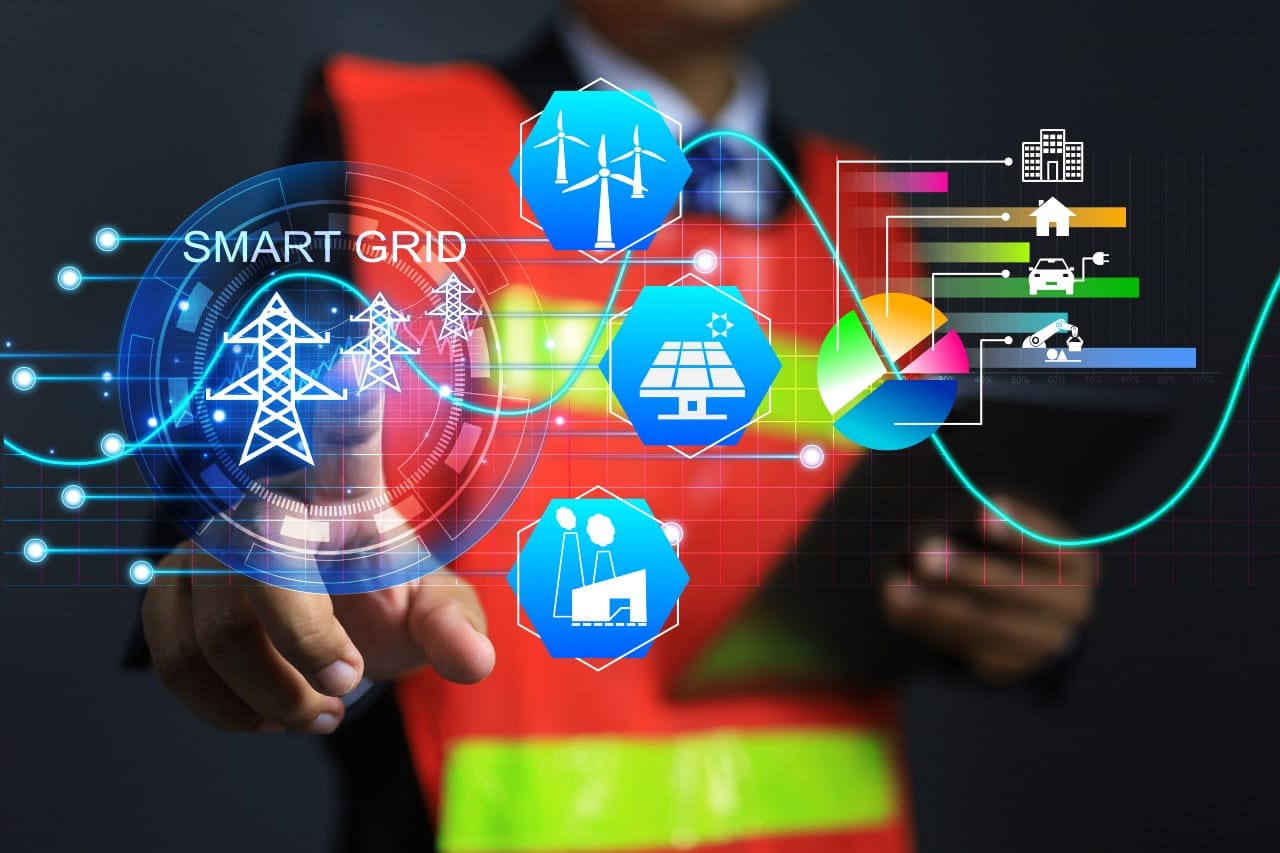
Our worldwide electric power supply systems are maintained in a careful balancing act between supply and demand. Unlike our systems that supply natural gas and water, the electrical power generated must match the electrical power demanded; there is virtually no storage to accommodate mismatch. Any mismatch results in unacceptable voltage and frequency variations leading to brownouts and blackouts. Regional control systems around the globe work around the clock, minute by minute, to adjust power generation, and demand, to match each other. This article looks at how our electrical system is balanced, and new balancing challenges imposed by intermittent renewable energy.
Challenges to Balance
If the demand for electricity was unchanging and generation was constant, balancing would be simple. But demand varies over the course of the day, plus varies with the weather, notably in places with high air conditioning loads or electric heating loads. Figure 1 below shows the total demand for the US 1 over the week 3/5/24 to 3/12/24. Note how demand is highest during the late afternoon and lowest during the early morning hours. Generation must ramp up or down to follow this demand curve, and also must be sufficient to meet peak demand which may spike on very hot or cold days.
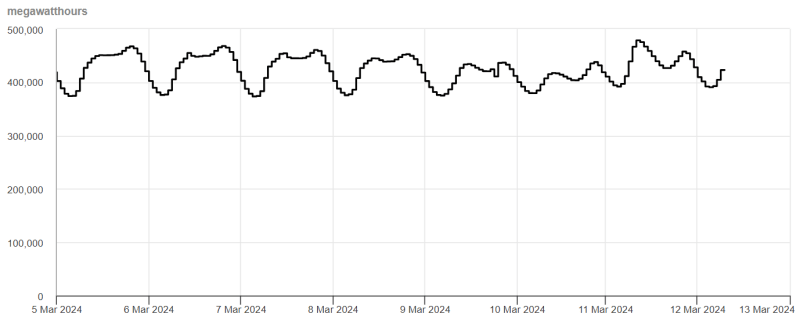
Historically, nearly all our generation sources were fairly constant in their output (think nuclear plants, large hydro, and big coal plants) or easily dispatched (think ‘peakers’ which are much like aircraft engines attached to generators). Fossil baseload plants could be slowly ramped up or down to match demand and peakers could be dispatched when higher ramp rates were required. Increased penetration of renewable energy—mostly solar and wind—is beneficially giving us cleaner generation, but is also introducing a new challenge: generation sources that are inherently intermittent, with output varying in response to the sun and wind. Figure 2 below shows the output of five generation sources in the US 1 over six days in March 2024.
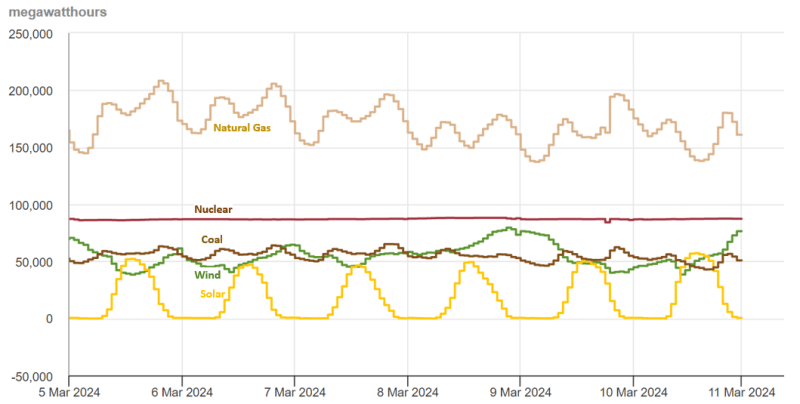
As shown in the diagram above, nuclear is a consistent ‘baseload’ source, with output nearly constant. Coal plants are also steady in their output but are intentionally ramped up and down slightly with load. Gas plants, which include gas-fired peakers, can follow demand quite well. Then we add in renewable generation: collectively, the wind across the US blows steadily but varies from day to day, while solar goes full off each night and maxes out at varying levels during the day.
Balancing in Practice
The US is broken down into 66 geographical regions, each of which employs a ‘balancing authority’ to keep power generation and demand in balance. The techniques used by these authorities include Automatic Generation Control (AGC) to ramp up or down power plants in real time, dispatch or shutdown of peakers, power import/export with other regions, and, to a lesser extent, techniques to reduce demand. These authorities look at economics as well, and select the lowest cost energy supplier when a choice exists, and do this all in real time. The California Independent Systems Operator (CA ISO), shown in Figure 3, is the balancing authority for a large portion of California and we’ll use that as an example of how balancing is managed.
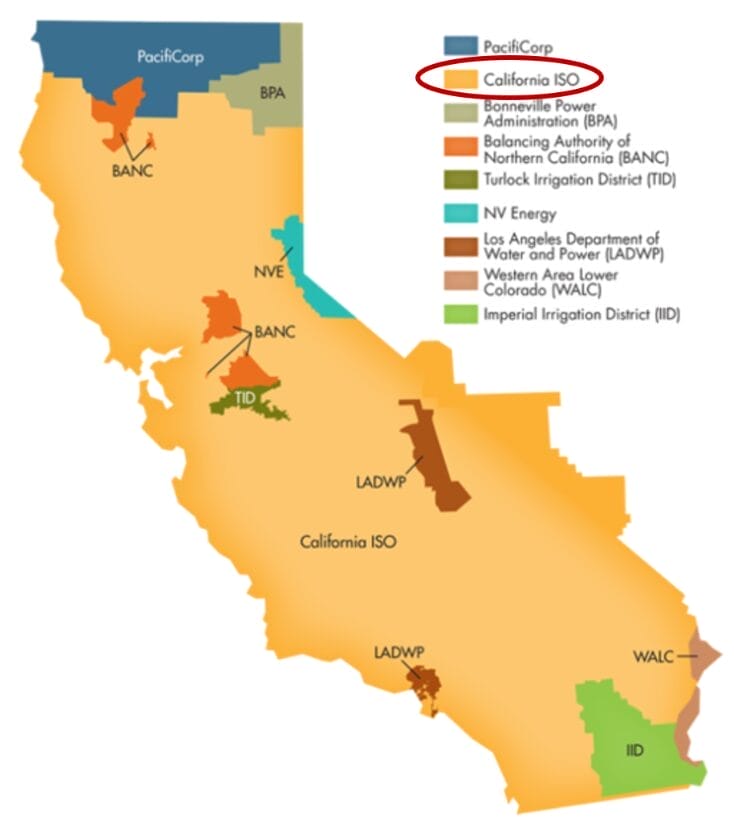
Figures 4 and 5 below show actual measurements of generation and demand in the CA ISO region in the morning hours of March 13. From 7:50am to 10:15am – less than three hours – the demand in the CA ISO region2 dropped 20% as the region moved from the early morning peak into the lower-demand later morning. At the same time, the sun got stronger, increasing renewable generation from about a third of the total to over three fourths of the total.
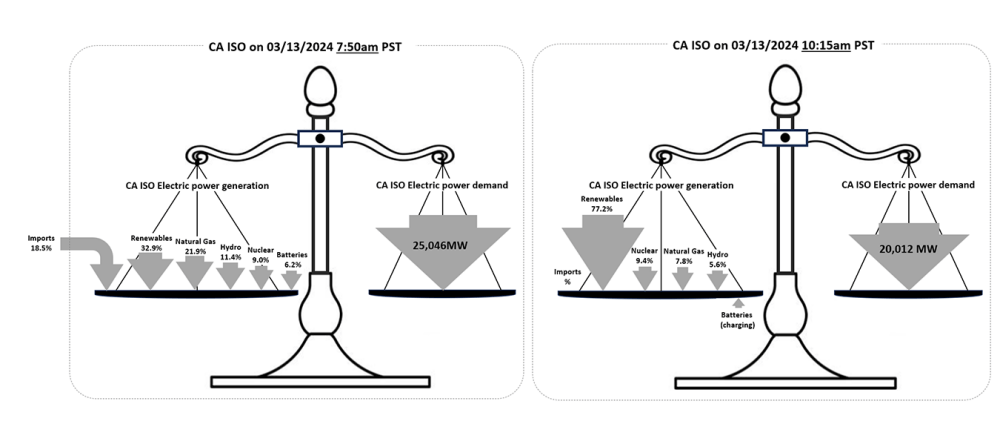
As renewable generation increased, power imports ramped down to zero, while natural gas, nuclear, and hydro all ramped down to lower levels. Note how batteries contributed significantly in the earlier morning and moved to charging mode later. Also of note: no coal or oil generation at all. To keep the CA ISO system in balance, and to deliver power at lowest cost, thousands of automatic and manual control decisions – minute-by-minute – were made from 7:50am to 10:15am. This ‘machine’ to keep everything in balance has been referred to as one of the most complex machines ever developed, and for good reason.
High Renewable Penetration Challenges
California has been able to adopt a very high penetration of intermittent, non-hydro renewable generation (37% in 20213) while maintaining system stability; a feat thought impossible by some experts years ago. This has been made possible through good planning and good fortune, and also by being an early adopter. Comprehensive longer-term planning4 resulted in the development of strong interties with adjacent regions (like the 3.2GW DC link with Oregon hydro), and creation of a diverse portfolio of reliable hydro and wind, plus some useful pump storage. But California is also fortunate to have lots of sun, wind, and mountains to make all that possible. Other parts of the US that are densely populated, wet, cold, and flat will be challenged to follow the California example. And, as an early adopter, California has been able to tap into excess energy from other adjacent regions; what happens when these regions also move to a high penetration of renewables? The fact remains that unless we increase our abilities to transmit large amounts of power over long distances (see Keep it Cool article No Transition without Transmission) and implement more extensive electrical storage solutions, renewable growth will hit the wall. Stay tuned for our next article on bulk electrical energy storage, entitled, Power Delivery – Batteries Not Included.
NovaTech Keep It Cool articles:
The New Energy Environment – The Role of the New Power Suppliers
Millions of New Grid-Connected Solar Installations Will Require New Monitoring and Control Solutions
Sources
1 https://www.eia.gov/electricity/gridmonitor/dashboard/electric_overview/US48/US48
2 https://www.caiso.com/todaysoutlook/Pages/supply.aspx
4 https://www.caiso.com/Documents/Integration-RenewableResourcesReport.pdf